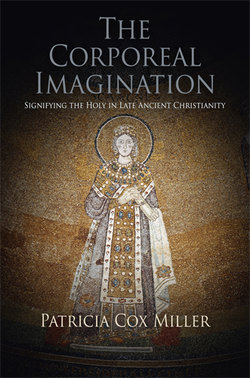Читать книгу The Corporeal Imagination - Patricia Cox Miller - Страница 11
ОглавлениеChapter Three
Dazzling Bodies
There is no better exemplar of Bill Brown’s “thing theory” in late ancient Christianity than a relic. As a specifically spiritual object, a relic is a mere object, a body part of a dead human being, that has become a “thing” because it can no longer be taken for granted as part of the everyday world of the naturalized environment of the death and decay of the human body. In antiquity, the relic as thing was a locus of surplus value: because it was a vehicle for the mediation of divine presence in human life—that is to say, a crucial nodal point linking the transcendent and earthly realms—a relic was both the facilitator as well as a signifier of a belief system in which the concept of intercession placed spiritual power squarely in the midst of the material world. In short, as thing, the relic represents the seemingly paradoxical use of the material to enhance the spiritual, as noted in Chapter 1.
As both the sign and the carrier of a relation between materiality and theology, the phenomenon of relics aptly illustrates a major feature of the material turn in late ancient Christianity, namely, the revaluation of the religious significance of the material world in a positive direction. This revaluation was, however, problematic: in the view of some, relics signaled a corporeal imagination run amok by investing the material world, in the form of parts of the human body, with too much extrahuman meaning. Given this troublesome aspect of the revaluation, the task of those who created positive interpretive frameworks for relics was basically twofold: first, to answer the question how a material object can have a spiritual life, that is, to explain how the necessary excess that marked relics as spiritual objects was not idolatrous, and second, to reeducate the senses of fellow Christians so as to enable them to perceive the material-spiritual relationship in relics. Their overall task was to articulate a religio-aesthetic environment within which the remains of special human beings could be apprehended as relics, that is, as spiritual objects worthy of ritual devotion.
This chapter focuses on how such relic-minded Christians as Prudentius of Calahorra, Asterius of Amaseia, and Paulinus of Nola created a context for apprehending body parts as relics by exercising what I have called a corporeal imagination, one that uses textual images whose ocular and affective immediacy contributes to, or even creates, the religious significance of the thing that is their focus. Their powerful verbal representations, often in the form of ekphrases, were a major component of the aesthetic style that vested in bones a signifying capacity that marked their emergence as relics. Further, their reliance on “dazzle”—that is, on the aesthetic sensibility associated with the late ancient cultural taste for color and brilliance—will be presented as an important contributor to the sensuously intense atmosphere within which the cult of relics achieved expression. Here, the “dissonant echoing” discussed in the previous chapter, which denotes a sensibility that avoided complete identification between matter and meaning, will be presented in terms of a poetics of the body that deformed ordinary perception in order to produce the figural gaze so crucial to the cult of relics.
